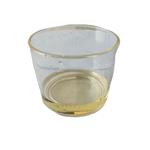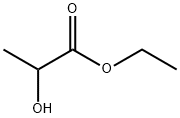Green solvent : Ethyl lactate
Dec 30,2019
Ethyl lactate (EL), also known as lactic acid ethyl ester, is a monobasic ester formed from lactic acid and ethanol, commonly used as a solvent. This compound is considered biodegradable and can be used as a water-rinsible degreaser. Ethyl lactate is found naturally in small quantities in a wide variety of foods including wine, chicken, and various fruits. The odor of ethyl lactate when dilute is mild, buttery, creamy, with hints of fruit and coconut. Ethyl lactate is produced from biological sources and can be either the levo (S) form or dextro (R) form, depending on the organism that is the source of the lactic acid. Most biologically sourced ethyl lactate is ethyl (−)-L-lactate, which is L-isomer [1]. Ethyl L-lactate is used in the preparation of food additives, aryl aldimines, fragrances and in pharmaceutical preparations. It can be considered as a green solvent in chemical industries due to its biodegradable nature. As a solvent, it used in the production of nitrocellulose, cellulose acetate and cellulose ethers [2].
Solvents are required for most of the chemical transformations to increase the contact between the reagents and catalysts and solvent also ensures a suitable isolation process of products from the reaction mixture Traditional solvents of synthetic organic chemists viz- benzene, carbon tetrachloride, and chloroform were replaced due to their toxic and carcinogenic effects; chlorofluorocarbons (CFCs) were banned because of their ozone-depleting activity and volatile organic compounds (VOCs) are involved in the generation of photochemical smog. Ethyl lactate is a bio-based, environmentally benign and economically viable solvent with effectiveness comparable to petroleum-based solvents [3].

Scheme 1 The green solvent ethyl lactate
The recyclability (scheme1) of this green solvent also makes a very prominent consequence on chemists for the replacement of hazardous organic solvents. From this discussion, it is very much clear that this biodegradable green solvent can be installed to design a large number of green reaction protocols.
Why EL is an alternative to traditional solvents, the properties in wide pressure–temperature ranges can explain. Santiago Aparicio and Rafael Alcalde studied the pressure–volume–temperature and pressure–viscosity–temperature behaviors are reported together with several derived properties of remarkable importance for process design purposes. A wide scope study on EL structure and properties is reported using a combined experimental/theoretical approach. EL structure in the liquid phase is characterized by remarkable intermolecular associations through H-bonding, leading to mainly cyclic dimers although the presence of higher complexes such as cyclic trimers or tetramers is also important. Intermolecular interactions are developed through hydroxyl/carbonyl interactions, whereas the alkoxy position is sterically hindered to develop the H-bonding. Alkylic groups tend to arrange in apolar domains across the fluid with tail/tail (terminal ethyl groups) arrangements. These complexes have remarkable association energies and their formation leads to a weakening of the intramolecular H-bonding through an out-of-plane movement of the hydroxyl group in EL. Calculated intermolecular interaction energies show a highly structured fluid, with low molecular mobility leading to low self-diffusion coefficients. Thermophysical properties reported show a dense fluid with moderate viscosity, which is a candidate suitable to be applied in different industrial fields [4].
References
[1] https://en.wikipedia.org/wiki/Ethyl_lactate
[2] https://www.alfa.com/en/catalog/A10900/
[3] Sanjay Paul, etc., Ethyl Lactate As a Green Solvent: A Promising Bio-compatible Media for Organic Synthesis, Current Green Chemistry, 2016, 3, 111-118.
[4] Santiago Aparicio and Rafael Alcalde, The green solvent ethyl lactate: an experimental and theoretical characterization, Green Chem., 2009, 11, 65–78.
- Related articles
- Related Qustion
- Ethyl Lactate: Natural Occurrence, Versatility and Eco-Friendly Potential Jan 9, 2025
Ethyl lactate, derived from lactic acid and ethanol, enhances food flavor and serves as a versatile, eco-friendly solvent in various industries.
- Ethyl lactate: properties, synthesis and biosynthetic pathway Dec 15, 2023
Ethyl lactate, a biodegradable solvent with wide-ranging applications, is synthesized chemically or biologically using Zr-catalysts and genetically engineered yeast.
- Ethyl lactate: application and safety Jul 12, 2023
Ethyl lactate is a versatile solvent with applications in chromatography, soil remediation and extraction of bioactive compounds. It is generally recognized as safe.
2,4,5-Trichloropyrimidine is used in the synthesis of potent and selective anaplastic lymphoma kinase (ALK-5) inhibitors, used as an anti-tumor treatment. It is also used in the synthesis of EGFR inhibitors[2,3].....
Dec 30,2019Pharmaceutical intermediatesBis(triphenylphosphine)palladium chloride is a coordination compound of palladium containing two triphenylphosphine and two chloride ligands. It is a yellow solid that is soluble in some organic solvents.....
Dec 30,2019Organic ChemistryEthyl lactate
97-64-3You may like
- Ethyl lactate
-

- $10.00 / 1KG
- 2025-04-18
- CAS:97-64-3
- Min. Order: 1KG
- Purity: 99%
- Supply Ability: 100 mt
- Ethyl lactate
-

- $0.00 / 25KG
- 2025-03-21
- CAS:97-64-3
- Min. Order: 1KG
- Purity: 99%
- Supply Ability: 50000KG/month
- Ethyl lactate
-

- $10.70 / 1KG
- 2024-10-11
- CAS:97-64-3
- Min. Order: 10KG
- Purity: 99%
- Supply Ability: 10000kg






